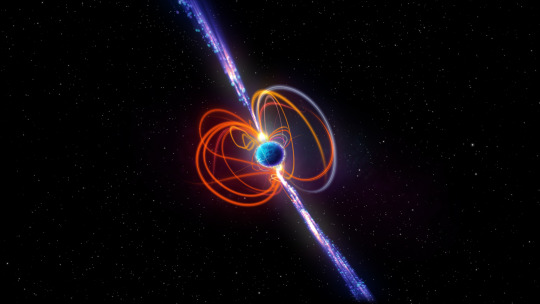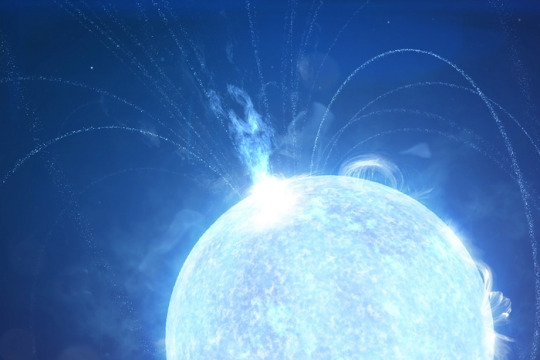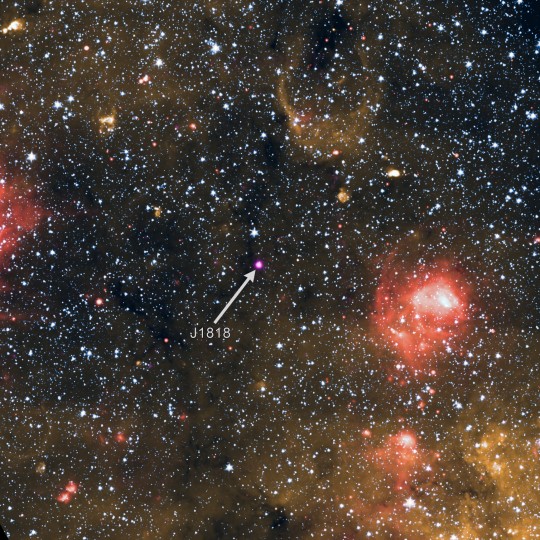#magnetar
Text

This artist impression shows HD 45166, a massive star recently discovered to have a powerful magnetic field of 43 000 gauss, the strongest magnetic field ever found in a massive star. Intense winds of particles blowing away from the star are trapped by this magnetic field, enshrouding the star in a gaseous shell as illustrated here.
Astronomers believe that this star will end its life as a magnetar, a compact and highly magnetic stellar corpse. As HD 45166 collapses under its own gravity, its magnetic field will strengthen, and the star will eventually become a very compact core with a magnetic field of around 100 trillion gauss — the most powerful type of magnet in the Universe.
HD 45166 is part of a binary system. In the background, we get a glimpse of HD 45166’s companion, a normal blue star that has been found to orbit at a far larger distance than previously reported.Credit:
ESO/L. Calçada
688 notes
·
View notes
Text
Researchers using Murriyang, CSIRO's Parkes radio telescope, have detected unusual radio pulses from a previously dormant star with a powerful magnetic field.
The paper, "Linear to circular conversion in the polarized radio emission of a magnetar," published in Nature Astronomy describe radio signals from magnetar XTE J1810-197 behaving in complex ways.
Magnetars are a type of neutron star and the strongest magnets in the universe. At roughly 8,000 light years away, this magnetar is also the closest known to Earth.
Continue Reading.
56 notes
·
View notes
Text
A magnetar is a type of neutron star with an extremely powerful magnetic field (∼109 to 1011 T, ∼1013 to 1015 G). The magnetic-field decay powers the emission of high-energy electromagnetic radiation, particularly X-rays and gamma rays ⚡️

#nasa#astronomy#astrophotography#astrophysics#physics#james webb space technology#james webb images#stars#magnetar#solar system#neutron stars#space advances#science acumen#nebula#powerful#space
85 notes
·
View notes
Photo

A magnetar dragon
102 notes
·
View notes
Text
"Researchers using Murriyang, CSIRO's Parkes radio telescope, have detected unusual radio pulses from a previously dormant star with a powerful magnetic field.
The paper, "Linear to circular conversion in the polarized radio emission of a magnetar," published in Nature Astronomy describe radio signals from magnetar XTE J1810-197 behaving in complex ways.
Magnetars are a type of neutron star and the strongest magnets in the universe. At roughly 8,000 light years away, this magnetar is also the closest known to Earth.
Most are known to emit polarized light, though the light this magnetar is emitting is circularly polarized, where the light appears to spiral as it moves through space."
""Our results suggest there is a superheated plasma above the magnetar's magnetic pole, which is acting like a polarizing filter," Dr. Lower said.
"How exactly the plasma is doing this is still to be determined.""
continue reading article
#astronomy#universe#space#star#magnetism#plasma#magnetar#energy#radio pulses#visible spectrum#frequency#light#spiraling#magnet#plasma physics#electromagnetism#electric universe#plasma universe#cosmos
6 notes
·
View notes
Text
Astronauta by Danilo Beyruth
I just translated to English a comic book only available in Brazil. It's about an astronaut in a space exploration mission, when his ship malfunctions and he gets stuck around a Magnetar. Question is, would you like to read it?
It's here in this drive.

It has a really nice art style too.
There are four more books after this story, I'll get around to translating them next.
#my posts#turma da mônica#astronauta msp#magnetar#comic books#the formatting is kinda ugly#I honestly didn't do a very pretty job#I just wanted to translate it
20 notes
·
View notes
Text
Draconis picks up Magnetar like a misbehaving cat. The gremlin is trying to annoy starholders and Draconis is tired of him making enemies
#Draconis#magnetar#Draconis hasn’t adopted him (yet) but he does feel some kind of responsibility to have him not make enemies
4 notes
·
View notes
Text
My collector OC

I finished the drawing and it looks ok :D
11 notes
·
View notes
Link
A weird, dead magnetized star has a solid surface - and a ring
By Troy Farah
9 notes
·
View notes
Text
Nuevo tipo de estrella da pistas sobre el misterioso origen de los magnetares
Los magnetares son los imanes más fuertes del universo. Estas estrellas muertas súper densas con campos magnéticos ultrafuertes se pueden encontrar en toda nuestra galaxia, pero los astrónomos no saben exactamente cómo se forman.
Ahora, utilizando múltiples telescopios en todo el mundo, incluidas las instalaciones del Observatorio Europeo Austral (ESO), los investigadores han descubierto una…

View On WordPress
2 notes
·
View notes
Text
It’s been almost six years but the sound of this weapon spinning up still invokes an emotion stronger than fear.
youtube
#Magnetar#Pulsar#Pulsar 2#Robot Wars#Robot Wars Series 10#BBC Robot Wars#RW Reboot Voice: ''DRAM SPEENAAHHH!''#Other spinners have a Death Hum#Magnetar has a Death Roar#At least you'll hear it coming so you know to get the binbags ready
2 notes
·
View notes
Photo

An artist's concept of a Magnetar,
Or a highly magnetic neutron star, which looks a bit like a frozen star.
NASA Goddard Space Flight Center
#art#render#concept#magnetar#cosmos#cosmic#universe#neutron star#star#frozen#goddard space flight center
10 notes
·
View notes
Photo

Volcano-like rupture could have caused magnetar slowdown On Oct. 5, 2020, the rapidly rotating corpse of a long-dead star about 30,000 light years from Earth changed speeds. In a cosmic instant, its spinning slowed. And a few days later, it abruptly started emitting radio waves. Thanks to timely measurements from specialized orbiting telescopes, Rice University astrophysicist Matthew Baring and colleagues were able to test a new theory about a possible cause for the rare slowdown, or “anti-glitch,” of SGR 1935+2154, a highly magnetic type of neutron star known as a magnetar. In a study published this month in Nature Astronomy, Baring and co-authors used X-ray data from the European Space Agency’s X-ray Multi-Mirror Mission (XMM-Newton) and NASA’s Neutron Star Interior Composition Explorer (NICER) to analyze the magnetar’s rotation. They showed the sudden slowdown could have been caused by a volcano-like rupture on the surface of the star that spewed a “wind” of massive particles into space. The research identified how such a wind could alter the star’s magnetic fields, seeding conditions that would be likely to switch on the radio emissions that were subsequently measured by China’s Five-hundred-meter Aperture Spherical Telescope (FAST). “People have speculated that neutron stars could have the equivalent of volcanoes on their surface,” said Baring, a professor of physics and astronomy. “Our findings suggest that could be the case and that on this occasion, the rupture was most likely at or near the star’s magnetic pole.” SGR 1935+2154 and other magnetars are a type of neutron star, the compact remains of a dead star that collapsed under intense gravity. About a dozen miles wide and as dense as the nucleus of an atom, magnetars rotate once every few seconds and feature the most intense magnetic fields in the universe. Magnetars emit intense radiation, including X-rays and occasional radio waves and gamma rays. Astronomers can decipher much about the unusual stars from those emissions. By counting pulses of X-rays, for example, physicists can calculate a magnetar’s rotational period, or the amount of time it takes to make one complete rotation, as the Earth does in one day. The rotational periods of magnetars typically change slowly, taking tens of thousands of years to slow by a single rotation per second. Glitches are abrupt increases in rotational speed that are most often caused by sudden shifts deep within the star, Baring said. “In most glitches, the pulsation period gets shorter, meaning the star spins a bit faster than it had been,” he said. “The textbook explanation is that over time, the outer, magnetized layers of the star slow down, but the inner, non-magnetized core does not. This leads to a buildup of stress at the boundary between these two regions, and a glitch signals a sudden transfer of rotational energy from the faster spinning core to the slower spinning crust.” Abrupt rotational slowdowns of magnetars are very rare. Astronomers have only recorded three of the “anti-glitches,” including the October 2020 event. While glitches can be routinely explained by changes inside the star, anti-glitches likely cannot. Baring’s theory is based on the assumption that they are caused by changes on the surface of the star and in the space around it. In the new paper, he and his co-authors constructed a volcano-driven wind model to explain the measured results from the October 2020 anti-glitch. Baring said the model uses only standard physics, specifically changes in angular momentum and conservation of energy, to account for the rotational slowdown. “A strong, massive particle wind emanating from the star for a few hours could establish the conditions for the drop in rotational period,” he said. “Our calculations showed such a wind would also have the power to change the geometry of the magnetic field outside the neutron star.” The rupture could be a volcano-like formation, because “the general properties of the X-ray pulsation likely require the wind to be launched from a localized region on the surface,” he said. “What makes the October 2020 event unique is that there was a fast radio burst from the magnetar just a few days after the anti-glitch, as well as a switch-on of pulsed, ephemeral radio emission shortly thereafter,” he said. “We’ve seen only a handful of transient pulsed radio magnetars, and this is the first time we’ve seen a radio switch-on of a magnetar almost contemporaneous with an anti-glitch.” Baring argued this timing coincidence suggests the anti-glitch and radio emissions were caused by the same event, and he’s hopeful that additional studies of the volcanism model will provide more answers. “The wind interpretation provides a path to understanding why the radio emission switches on,” he said. “It provides new insight we have not had before.” IMAGE....An artist's impression of a magnetar eruption. Image courtesy of NASA's Goddard Space Flight Center
3 notes
·
View notes
Text
If a magnetar was located a sixth of the way to the Moon (about 40,000 miles), it would wipe the data from all of the credit cards on Earth.
📷: X-ray: NASA/CXC/Univ. of West Virginia/H. Blumer; Infrared (Spitzer and Wise): NASA/JPL-CalTech/Spitzer

#astrophysics#astronomy#nasa#physics#quantum mechanics#quantum physics#solar system#nebula#stars#magnetar#hubble
3 notes
·
View notes
Text
Are Magnetars The Most Powerful Star In The Universe?

A magnetar is a kind of neutron star with the strongest magnetic fields now understood to exist in the Universe.
It is the little pink dot in the middle of this picture.
A magnetar would erase all of the information on Earth's credit cards if it were situated around 64,000 kilometers from the Moon.
A refrigerator magnet has a strength of around 100 Gauss compared to the Earth's magnetic field's value of roughly 1.

About a million billion Gauss of magnetic fields are present in magnetars.
The field of a Magnetar is roughly a trillion times stronger than the field of the Earth and about a thousand times greater than a typical neutron star.
The universe's most magnetic stars are without a doubt magnetars.
~ Jai Krishna Ponnappan
Find Jai on Twitter | LinkedIn | Instagram
#Magnetar#Neutron star#Astronomy#Space#Universe#Deep space#stars#magnetic field#Magnetars#NASA Chandra Xray telescope
4 notes
·
View notes
Text
"An international research team led by Michael Kramer and Kuo Liu from the Max Planck Institute for Radio Astronomy in Bonn, Germany, have studied magnetars to uncover an underlying law that appears to apply universally to neutron stars."
"To their surprise, the researchers found that the timescale of magnetars and that of the other types of neutron stars all follow the same universal relationship, scaling exactly with the rotation period. The fact that a neutron star with a rotation period of less than a few milliseconds and one with a period of nearly 100 seconds behave like magnetars suggests that the intrinsic origin of the subpulse structure must be the same for all radio-loud neutron stars.
This reveals information about the plasma process responsible for the radio emission itself, and it offers a chance to interpret similar structures seen in FRBs as the result of a corresponding rotational period.
"When we set out to compare magnetar emission with that of FRBs, we expected similarities," says Michael Kramer, first author of the paper and Director at MPIfR. "What we didn't expect is that all radio-loud neutron stars share this universal scaling."
"We expect magnetars to be powered by magnetic field energy, while the others are powered by their rotational energy," says Kuo Liu. "Some are very old, some are very young, and yet all seem to follow this law.""
continue reading article
#cosmology#astronomy#universe#space#star#magnetar#emission#radiation#energy#plasma physics#magnetic field#magnetism#electromagnetism#oscillation#rotation#spinning#scaling#cyclical#plasma#science#discovery
2 notes
·
View notes